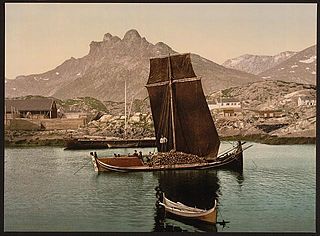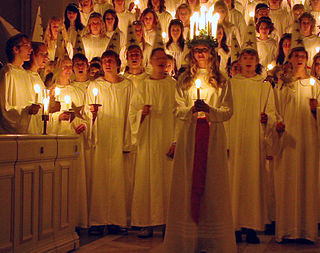 W
WThe architecture of Norway has evolved in response to changing economic conditions, technological advances, demographic fluctuations and cultural shifts. While outside architectural influences are apparent in much of Norwegian architecture, they have often been adapted to meet Norwegian climatic conditions, including: harsh winters, high winds and, in coastal areas, salt spray.
 W
WFor much of its history Norwegian art is usually considered as part of the wider Nordic art of Scandinavia. It has, especially since about 1100, been strongly influenced by wider trends in European art. After World War II, the influence of the United States strengthened substantially. Due to generous art subsidies, contemporary Norwegian art has a high production per capita.
 W
WConstitution Day is the national day of Norway and is an official public holiday observed on 17 May each year. Among Norwegians, the day is referred to simply as syttende mai, Nasjonaldagen or Grunnlovsdagen, although the latter is less frequent.
 W
WHausmania is a self-managed social centre and cultural house in Oslo, Norway. It was squatted in 1999 by a group of artists and run based on collectivist ideology. It is located alongside other squats at Hausmannsgate 34, in a zone designated as a cultural quarter. Hausmannsgate 42 was evicted in 2016. The centre hosts artist ateliers, a theatre, galleries, an internet space, a vegan café and a legal graffiti wall. Nearby are Kafe Hærverk and Vega Scene.
 W
WHygge is a Danish and Norwegian word for a mood of coziness and comfortable conviviality with feelings of wellness and contentment. As a cultural category with its sets of associated practices hygge has more or less the same meanings in Danish and Norwegian, but the notion is more central in Denmark than in Norway. The emphasis on hygge as a core part of Danish culture is a recent phenomenon, dating to the late 20th century.
 W
WA millennium site is a site selected by a Norwegian municipality or county municipality to mark the transition to the 2000s. In Norway it was decided that the counties and municipalities would choose one millennium site for each county and municipality.
 W
WThe National Archives of Norway (Riksarkivet) is the institution responsible for preserving archive material from Norwegian state institutions, as well as contributing to the preservation of private archives. It does this work in cooperation with the regional state archives, together with which it forms the National Archival Services of Norway (Arkivverket).
 W
WThe Nordland boat, is a type of fishing boat that has been used for centuries in northern counties of Nordland, Troms and Finnmark of Norway and derives its name from Nordland county where it has a long history. It has dominated the Lofoten and Vesterålen islands fishing industry for centuries and is closely related to the old Viking longships.
 W
WOla Nordmann is a national personification of Norwegians, either for individuals or collectively. It is also used as a placeholder name. The female counterpart is Kari Nordmann, and collectively they are referred to as Ola og Kari Nordmann.
 W
WNorges Skaal, was first written in 1771 by Johan Nordahl Brun in Copenhagen during the period when Norway was in a personal union with Denmark as a drinking song for the Norwegian literary society in Copenhagen.
The Norwegian Archive, Library and Museum Authority is a Norwegian government agency under the Norwegian Ministry of Culture and Church Affairs responsible for archival, library and museum services.
 W
WNorwegian knitting (strikking) has a history dating from the 16th century.
 W
WThe Norwegian Year of Cultural Heritage 2009 or Kulturminneåret 2009 was aimed at highlighting the diversity and importance of Norway's cultural heritage for all sectors of the community. Under the theme of Cultural Heritage in Everyday Life, the arrangements were intended to involve both ordinary citizens and professionals at local, regional and national levels.
 W
WOlsok is a national day of celebration in the Nordic countries of Norway and the Faroe Islands, and also in the provinces of Härjedalen in Sweden and Savonlinna in Finland.
 W
WRosemåling, rosemaling, rosmålning or kurbits are the names of a traditional form of decorative folk art that originated in Scandinavia. Rosemåling is a style of Norwegian decorative painting on wood that uses stylized flower ornamentation, predominantly primary and secondary colors, scrollwork, lining and geometric elements, often in flowing patterns. Landscape and architectural elements are also common. Many other decorative painting techniques were used such as glazing, spattering, marbleizing, manipulating the paint with the fingers or other objects.
 W
WThe russefeiring is a traditional celebration for Norwegian high school pupils in their final spring semester. Pupils that take part in the celebrations are known as russ. The russefeiring traditionally starts around 20 April and ends on 17 May, the Norwegian Constitution day. Participants wear coloured overalls. Some form groups that name a bus, car or van. Some celebrate almost continually during this period. Drunkenness and public disturbances are regularly linked to the celebration.
 W
WSaint Lucy's Day, also called the Feast of Saint Lucy, is a Christian feast day observed on 13 December. The observance commemorates Lucia of Syracuse, an early-4th-century virgin martyr under the Diocletianic Persecution, who according to legend brought food and aid to Christians hiding in the Roman catacombs, wearing a candle lit wreath on her head to light her way and leave her hands free to carry as much food as possible. Her feast day, which coincided with the shortest day of the year prior to calendar reforms, is widely celebrated as a festival of light. Falling within the Advent season, Saint Lucy's Day is viewed as a precursor of Christmastide, pointing to the arrival of the Light of Christ in the calendar on Christmas Day.
 W
WSelbuvott is a knitted woolen mitten, based on a pattern from Selbu in Norway. Like all mittens, the purpose of selbuvott is to keep hands warm during winter, with one large space for fingers and a separate smaller section for the thumb. The pattern is a Selburose, which is a traditional rose from the Selbu area, shaped like an octagram. Marit Guldsetbrua Emstad first knitted the pattern into a pair of mittens in 1857, and sold it through Husfliden in Trondheim in 1897. Selbuvott is possibly the most-worn knitted pattern in Norway.
 W
WSmoking in Norway is banned indoors in public buildings and aboard aircraft or other means of public transport. In addition, it is illegal to smoke in outdoor locations that are close to children's schools and hospitals, and it is illegal to advertise, promote or sponsor any tobacco products to the public; however, this law does not apply to tobacconist shops which are allowed to advertise tobacco related products.